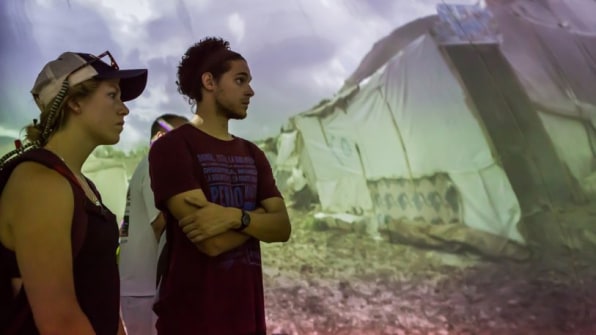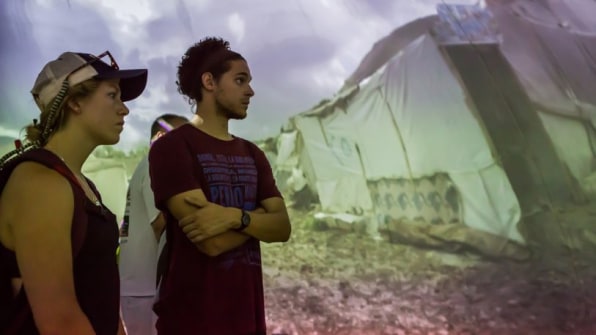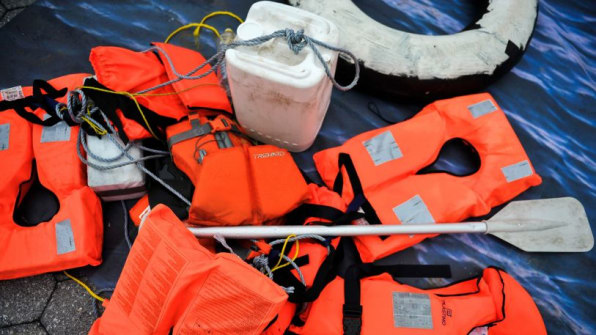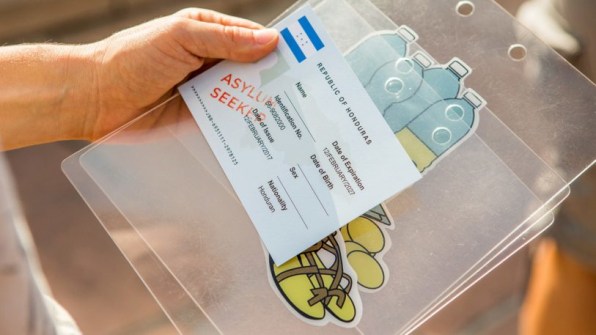
13 Oct This VR Exhibit Lets You Witness The Refugee Crisis Firsthand
Inside the dome at the entrance to “Forced from Home,” an interactive exhibit created by Doctors Without Borders/Médecins San Frontièrs (MSF), an image of the arid landscape around the border between Mexico and Guatemala fills the space; above, there’s a view of the sky scattered with clouds, and along one section of the dome, a wall painted with the phrase: ¡Bienvenidos migrantes! The scene shifts to the dining room of a hostel in Ixtepec, Oaxaca in southern Mexico, where Pedro, Diana, and their three children have just arrived after fleeing violence in their home country of Honduras. As Pedro and Diana alternate telling their story, the 360-degree view captures scenes of the hostel and the country around it, where they hope to make a new life for themselves.
Using a combination of 360-degree video and virtual reality Forced from Home immerses visitors in the journey of a refugee, from their life in their home country, through the route they travel and obstacles they face along it. The exhibit, which first opened in a handful of east coast cities last year, is re-launching for a west coast tour this fall; it’s currently in Seattle at the South Lake Union Discovery Center, and will later make its way to Portland, Oakland, and Santa Monica.

Pedro and Diana’s story is not the only one told through the 10,000 square-foot exhibit: In Forced from Home, MSF also follows refugees in Iraq, Lebanon, Tanzania, and South Sudan, all of whom have fled strife and conflict in their homes. From the 360-video screening at the beginning, the exhibit moves through a series of stations illustrated with photographs and tangible items that illustrate the refugee experience; some MSF equipment is displayed alongside items like passports. The exhibit ends with a series of VR experiences that capture a through-their-eyes look at the scenes visitors have just been learning about.
Alongside the medical work that MSF does, there is, Cone says, “an organizational commitment to bear witness to the conditions of our patients.” And the plight of refugees is a large focus of the organization: “Doctors Without Borders is a medical humanitarian organization, working mainly in conflict zones or post-conflict areas,” Jason Cone, executive director of MSF USA, tells Fast Company. “The vast majority of the patients we serve have been forcibly displaced.”
The history of “Forced From Home” actually dates much farther back than last year; in the mid-1990s, MSF opened an exhibit called “A Refugee Camp In the Heart of the City” in New York’s Central Park; over the course of a decade, it traveled through Europe and the United Arab Emirates. Because it was 20 years ago, the exhibit lacked the 360-video and VR elements of the contemporary iteration, but it asked visitors to take the same empathetic stance toward the refugee crisis, which at the time, numbered around 33 million.

“Today, we’re talking about 65 million refugees and internally displaced people,” Cone says. “The impetus of the exhibit now is really to bring the stories of our patients to the American public, and to leverage the developments in multimedia communication to do so.” “Forced From Home” comes at a time when America’s stance–and indeed, that of many other countries–is particularly hostile to outsiders; Donald Trump continues to push for the development of a border wall between the U.S. and Mexico, while constricting the number of refugees the country will accept from overseas and attempting to bar entry to people from Syria, Venezuela, Libya, and others. Initiatives like Refugee Republic, an immersive site on which visitors can click through maps, photographs, and recordings, and the Migration Museum Project, which is collecting artwork from the refugee camps and hopes to establish a permanent exhibition in the U.K., are working to highlight the human side of the crisis. MSF’s exhibit wants to do the same, using the most up-to-date technology possible.
Through the exhibit, produced with the studio Visualise, MSF wants “to close the distance between what seems like a very far-off problem,” Cone says. The 360-degree video at the beginning, he adds, is designed to situate people in the midst of the physical location–you will find yourself on a rickety boat in the middle of the Mediterranean, trying to make it to Italy, and inside a tent in a refugee camp in Lebanon or South Sudan. These are all places where MSF works; “having been in the places where these videos were filmed, they really to make you feel like you’re there,” Cone says.

After the video, visitors grab cards representing essentials refugees might grab before leaving home–money, medicine, clothing, food. Throughout the tour, as MSF staff lead them along the route, they have to gradually discard the items. “Along the way, refugees will have to sell things for money, or they might be robbed,” Cone says. “This is meant to show how difficult it is to make the decision of what to hold onto, and what to part with.”
At the end of the exhibit, there’s an opportunity for visitors to donate to MSF, but fundraising is not the primary goal of the exhibit. Public education is, and in that respect, it’s been successful: More than 22,600 people came out to the exhibit when it toured the east coast last year, and halfway through the west coast tour, the exhibit has welcomed over 10,000.
Forced from Home closes in mid-November in Santa Monica, but the MSF team is eyeing another tour for the following year; as the refugee crisis shows no signs of abating, the work that MSF is doing to communicate the reality of that experience will remain important. “In today’s political discourse, refugees and displaced people have been transformed from victims trying to survive circumstances completely out of their control, into threats to the countries that they’re trying to seek safety in,” Cone says. “This is really about trying to confront people with, and bring back some humanity into the understanding of these issues, and make the numbers less abstract.”
Source: Fast Company




Sorry, the comment form is closed at this time.